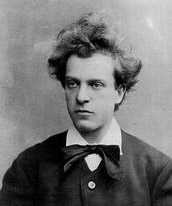Hans Rott
Hans Rott (1 August 1858 – 25 June 1884) was an Austrian composer and organist. His music is little-known today, though he received high praise in his time from Gustav Mahler and Anton Bruckner.

Life
Rott was born in Braunhirschengrund, a suburb of Vienna. His mother Maria Rosalia (1840–1872, maiden name Lutz) was an actress and singer. His father Carl Mathias Rott (real name Roth, born 1807, married 1862) was a famous comic actor in Vienna who was crippled in 1874 by a stage accident which led to his death two years later.
Studies
Hans was left alone to continue his studies at the Conservatory. Fortunately, both his skill and financial need were recognized and he was excused from paying tuition. While studying, he briefly roomed with Gustav Mahler and Rudolf Krzyzanowsky. He studied piano with Leopold Landskron and Josef Dachs, harmony with Hermann Graedener, counterpoint and composition—like Mahler—with Franz Krenn.
He studied organ with Bruckner, starting in 1874, and graduating from Bruckner's organ class in 1877, with honors. Bruckner said that Rott played Bach very well, and even improvised wonderfully (a high compliment since Bruckner himself was a great improviser). Rott was also influenced by the works of Wagner, and even attended the very first Bayreuth Festival in 1876.
Compositions
During that time Rott was also organist at the Piarist church "Maria Treu" in Vienna. For the final year of his studies in 1878, Rott submitted the first movement of his Symphony in E major to a composition contest. The jury, except Bruckner, was very derisive of the work. After completing the Symphony in 1880, Rott showed the work to both Brahms and Hans Richter, in order to get it played. His efforts failed. Brahms did not like the fact that Bruckner exerted great influence on the Conservatory students, and even told Rott that he had no talent whatsoever and that he should give up music. Unfortunately, Rott lacked Mahler's inner resolve, and whereas Mahler was able to overcome many of the obstacles in his life, Rott was brought down by mental illness. The symphony has been recorded by BIS, CPO, Acousence, Hyperion, Ondine & RCA. Hans Rott also wrote a Symphony for String Orchestra in A flat major, in three movements, (1874—75), and a String Quartet in C minor, a student work in five movements. They have both been recorded on the Acousence Records label #ACO-CD 20205. (2005)
Final years
Rott's mind snapped in October 1880, whilst on a train journey. He was reported to have threatened another passenger with a revolver, claiming that Brahms had filled the train with dynamite. Rott was committed to a mental hospital in 1881, where despite a brief recovery, he sank into depression. By the end of 1883 a diagnosis recorded 'hallucinatory insanity, persecution mania—recovery no longer to be expected.' He died of tuberculosis in 1884, aged only 25. Many well-wishers, including Bruckner and Mahler, attended Rott's funeral at the Zentralfriedhof in Vienna.
Legacy
Mahler wrote of Rott
a musician of genius ... who died unrecognized and in want on the very threshold of his career. ... What music has lost in him cannot be estimated. Such is the height to which his genius soars in ... [his] Symphony [in E major], which he wrote as 20-year-old youth and makes him ... the Founder of the New Symphony as I see it. To be sure, what he wanted is not quite what he achieved. … But I know where he aims. Indeed, he is so near to my inmost self that he and I seem to me like two fruits from the same tree which the same soil has produced and the same air nourished. He could have meant infinitely much to me and perhaps the two of us would have well-nigh exhausted the content of new time which was breaking out for music.[1]
Thanks to Rott's friends, some of his music manuscripts have survived in the music collection of Vienna's national library. This includes Rott's Symphony in E major, and sketches for a second Symphony that was never finished. The completed symphony is remarkable in the way it anticipates some of Mahler's musical characteristics. In particular the third movement is unnervingly close to Mahler. The Finale includes references to Brahms's First Symphony. Mahler also spoke well of Rott's Lieder, of which all eight surviving complete songs have been performed in concert since 2002 and four sung by Dominik Wörner were recorded in 2009 on the Ars label.[2] We also know of a Sextet, which Mahler never heard and has also been lost. In his last years, Rott wrote a lot of music, only to destroy what he wrote soon after writing it, saying it was worthless.
Bruckner and Mahler were the first to recognise Rott's talent. Mahler himself included references to Rott's work in his own music. However, in the 20th century, Rott's work was largely forgotten; and only in 1989 was Rott's Symphony in E major finally premiered by the Cincinnati Philharmonia Orchestra under Gerhard Samuel, in a performing edition prepared by Paul Banks. A CD recording followed.
Other recordings of the symphony have since been issued, and other Rott works have been occasionally revived, including his Julius Caesar Overture, Pastoral Overture and Prelude for Orchestra.
References
- ↑ Quoted in the liner notes for the Gerhard Samuel recording of Rott's Symphony, Hyperion Records (1989)
- ↑ <http://www.hans-rott.de/werke/pworks.htmref>; http://www.ars-produktion.de/Gustav_MahlerFreunde_und_Zeitgenossen/topic/Suchergebnis/shop_art_id/267/tpl/shop_article_detail.; http://www.unsungcomposers.com/forum/index.php/topic,3655.msg39475.html#msg39475
External links
|